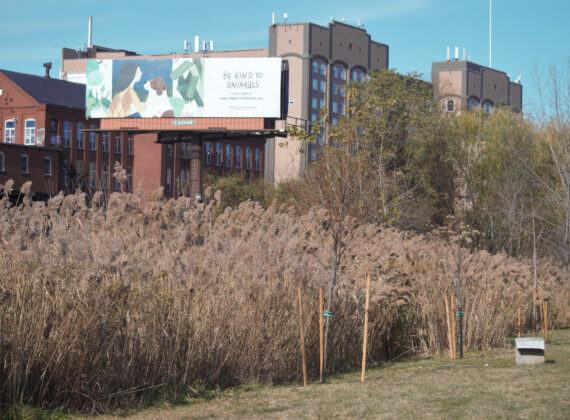Last Saturday, about 25 people took part in a free walking tour through parts of the Frog Hollow neighborhood. The purpose of this was mainly to highlight the remainder of the Lyric Theater, but also to show some of the other interesting historical and cultural aspects of the area. For those who missed it, here’s how it went.
The group met up at La Paloma Sabanera and headed up Babcock Street to the Park Branch of the Hartford Public Library.
 Various participants chimed in with what they knew about the mural pieces on display, which had been on the Lyric Theater before its partial demolition. Worried that some of these panels might accidentally be discarded, residents had the artwork removed and secured.
Various participants chimed in with what they knew about the mural pieces on display, which had been on the Lyric Theater before its partial demolition. Worried that some of these panels might accidentally be discarded, residents had the artwork removed and secured.

Youth visiting the library have been curious about the artwork, which has allowed for educational conversations. During the tour, we learned how murals tend to be respected by those in the neighborhood. Back in the day, when Victor Pacheco, the artist, returned to touch up and expand on his artwork, some asked him what he was doing, as they were afraid someone was vandalizing the panels.
 We had time to walk around the library to see the articles, photos, and advertisements that kids from Burns Elementary found in archives.
We had time to walk around the library to see the articles, photos, and advertisements that kids from Burns Elementary found in archives.
 There is also artwork by Balam Soto on display at the library, which has nothing to do with the Lyric Theater, but is still cool.
There is also artwork by Balam Soto on display at the library, which has nothing to do with the Lyric Theater, but is still cool.
From there, the group walked down Park Street, continuing its discussion of the changing ethnic makeup of the area, which is visible in the restaurants and churches. We stopped across the street from the Pelican Tattoo building.
 The artwork on this building was done by Sofia Maldonado, who has also done a mural on 42nd Street. Joe, the owner of the building, joined up with the tour and has been supportive of the Frog Hollow NRZ and Lyric Theater District efforts.
The artwork on this building was done by Sofia Maldonado, who has also done a mural on 42nd Street. Joe, the owner of the building, joined up with the tour and has been supportive of the Frog Hollow NRZ and Lyric Theater District efforts.
We then turned our attention to the remainder of the Lyric Theater and talked about its history and the recent demolition of the part closest to Broad Street.

The structure made it through the winter without roof collapse or any major problems. From here, the group went around back to where the other part of the building was demolished; we had some light refreshments while taking turns looking inside the building.
 We weren’t permitted to go further than a step inside, but that was enough to see some of the detail remaining from the historic building.
We weren’t permitted to go further than a step inside, but that was enough to see some of the detail remaining from the historic building.

The ceiling has obviously seen better days.

In discussions of what to do with this space, a few ideas keep popping up. One is to move the Park Branch of the library here, as it is currently a very cramped rental space with no room for expansion. Another idea is some type of cultural center.

From here, we traveled past the building that was used as the Immaculate Conception shelter; it is being phased out for that use. Casa de Francisco, on Hungerford Street, is a newer facility with units of “supportive housing.”
 On our journey toward Billings Forge, we learned a little about Che Tango:
On our journey toward Billings Forge, we learned a little about Che Tango:
 On our second-to-last official stop, we saw youth practicing their breakdancing moves:
On our second-to-last official stop, we saw youth practicing their breakdancing moves:

This ongoing hip hop class is one of the various classes offered at Billings Forge; others include Salsa, women’s self defense, and Shaolin Kung Fu.
On our way to the last destination, we passed by ghost ads and the Lyceum, which has been used by the Lithuanian-American Society, and at one point, as a punk club, among its many other incarnations.
 The event ended with free popcorn and a screening of Roman Holiday at La Paloma Sabanera.
The event ended with free popcorn and a screening of Roman Holiday at La Paloma Sabanera.
